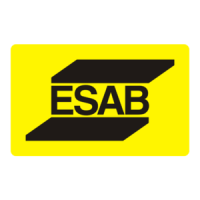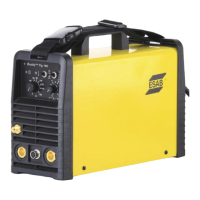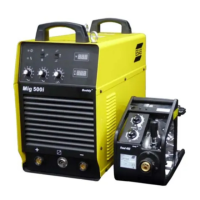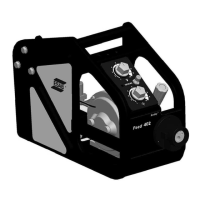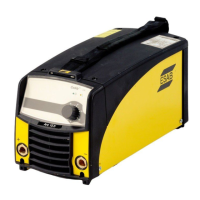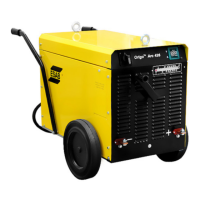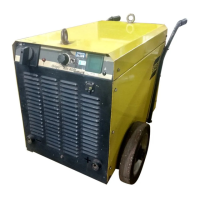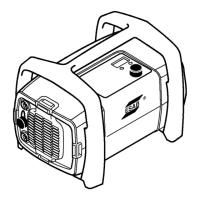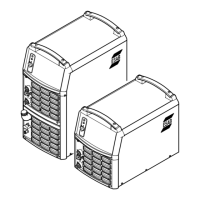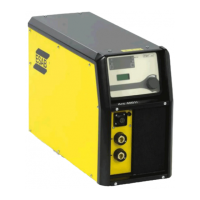Do you have a question about the ESAB Buddy Arc 200 and is the answer not in the manual?
Lists the equipment models covered by the declaration.
Details stock codes and serial number ranges for models.
Specifies the brand name of the equipment.
Provides the name and address of the manufacturer or representative.
Lists the standards applied in the equipment's design.
Notes restrictive use and intended location for Class A equipment.
Familiarise with operation, emergency stops, function, safety precautions.
Ensure no unauthorized persons and operator protection.
Ensure a suitable environment and free from drafts.
Wear recommended PPE like safety glasses, flame-proof clothing.
Secure return cable, high voltage work, fire extinguisher availability.
Do not use the power source for thawing frozen pipes.
Details the power source and included accessories.
Defines duty cycle percentage for welding/cutting at load.
Explains IP code for protection against objects/water.
Indicates design for areas with increased electrical hazard.
Position source to ensure cooling air inlets/outlets are not obstructed.
Connect to correct voltage, fuse rating, and earth connection.
Details control panel, cable connections, and power supply switch.
Connects welding/return cables to terminals and workpiece.
Explains indicators for power ON and overheating.
Describes thermal overload trip and indicator lamp.
Introduces MMA welding process and current setting.
Covers striking arc, manipulation, anti-pick-up, and joint forms.
Basis for selecting electrode diameter and storage advice.
Overview of TIG welding process and required equipment.
Covers striking arc and joint forms for TIG welding.
Check power source for dirt and cleaning methods.
Clean and replace wear parts for trouble-free welding.
Checks for issues when no arc is present.
Checks for issues when welding current is interrupted.
Checks for issues causing frequent thermal cut-outs.
Checks for issues leading to poor welding performance.
Emphasizes using authorized ESAB original spare parts.
Handle equipment components and coolant according to local regulations.
Provides the electrical schematic of the power source.
Lists order numbers for welding power sources and spare parts.
Lists available accessories like cables and TIG torches.
Lists the equipment models covered by the declaration.
Details stock codes and serial number ranges for models.
Specifies the brand name of the equipment.
Provides the name and address of the manufacturer or representative.
Lists the standards applied in the equipment's design.
Notes restrictive use and intended location for Class A equipment.
Familiarise with operation, emergency stops, function, safety precautions.
Ensure no unauthorized persons and operator protection.
Ensure a suitable environment and free from drafts.
Wear recommended PPE like safety glasses, flame-proof clothing.
Secure return cable, high voltage work, fire extinguisher availability.
Do not use the power source for thawing frozen pipes.
Details the power source and included accessories.
Defines duty cycle percentage for welding/cutting at load.
Explains IP code for protection against objects/water.
Indicates design for areas with increased electrical hazard.
Position source to ensure cooling air inlets/outlets are not obstructed.
Connect to correct voltage, fuse rating, and earth connection.
Details control panel, cable connections, and power supply switch.
Connects welding/return cables to terminals and workpiece.
Explains indicators for power ON and overheating.
Describes thermal overload trip and indicator lamp.
Introduces MMA welding process and current setting.
Covers striking arc, manipulation, anti-pick-up, and joint forms.
Basis for selecting electrode diameter and storage advice.
Overview of TIG welding process and required equipment.
Covers striking arc and joint forms for TIG welding.
Check power source for dirt and cleaning methods.
Clean and replace wear parts for trouble-free welding.
Checks for issues when no arc is present.
Checks for issues when welding current is interrupted.
Checks for issues causing frequent thermal cut-outs.
Checks for issues leading to poor welding performance.
Emphasizes using authorized ESAB original spare parts.
Handle equipment components and coolant according to local regulations.
Provides the electrical schematic of the power source.
Lists order numbers for welding power sources and spare parts.
Lists available accessories like cables and TIG torches.
| Input Frequency | 50/60 Hz |
|---|---|
| Output Current Range | 5-200 A |
| Duty Cycle at 200 A | 25% |
| Duty Cycle at 140 A | 60% |
| Enclosure Class | IP23 |
| Rated Output Voltage | 28 V |
| Efficiency | 85% |
| Insulation Class | H |
| Protection Class | IP23 |
| Electrode Diameter Range | 1.6-5.0 mm |
| Input Voltage | 230 V |
| Process | MMA |
| Standards | IEC/EN 60974-1, IEC/EN 60974-10 |
| Output at 30% Duty Cycle | 200 A |
| Output at 60% Duty Cycle | 140 A |
| Output at 100% Duty Cycle | 110 A |
